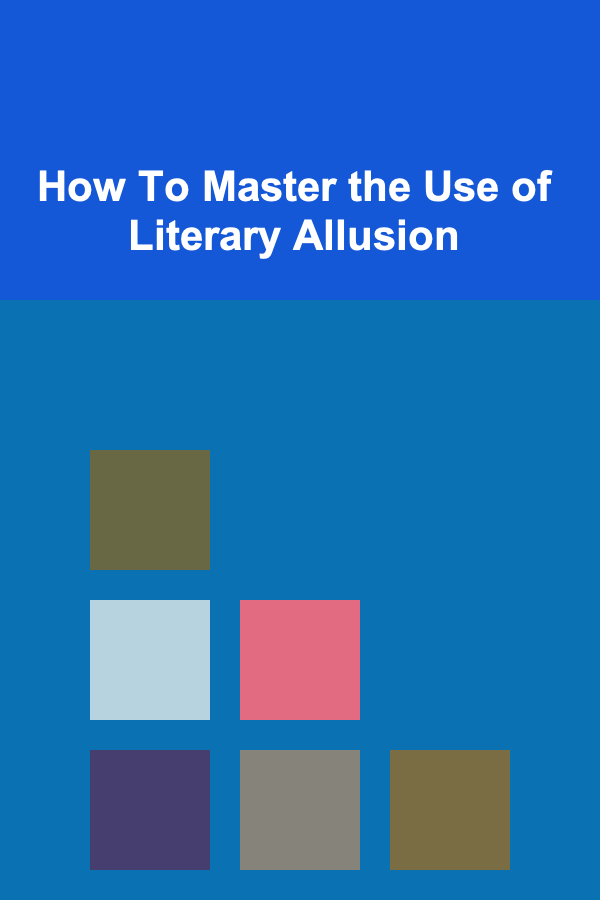
How To Master the Use of Literary Allusion
ebook include PDF & Audio bundle (Micro Guide)
$12.99$10.99
Limited Time Offer! Order within the next:

Literary allusion is one of the most powerful tools available to a writer, enriching their work with depth, meaning, and connections to other texts. It's a technique that allows authors to refer to other works of literature, historical events, figures, or myths, without directly explaining them. Instead of spelling out a reference, they assume the reader's familiarity with these allusions, allowing for a more nuanced understanding of the text. Mastering literary allusion not only strengthens your writing but also provides an avenue to explore cultural, historical, and intellectual contexts that resonate with readers on a deeper level.
What is Literary Allusion?
At its core, a literary allusion is a brief reference to a person, place, thing, or idea from a work of literature, history, mythology, or another cultural context. The key aspect of an allusion is that it is indirect---rather than fully describing a character or event, the writer makes a brief reference, trusting that the reader will recognize it and understand its significance. For example, when an author mentions "a modern-day Gatsby," they are alluding to F. Scott Fitzgerald's The Great Gatsby and implying that the character has qualities similar to Gatsby, such as wealth, ambition, and a tragic flaw.
Allusions can draw on a wide range of cultural sources, from classical mythology to contemporary pop culture. The more familiar the source, the more effective the allusion becomes, as it leverages shared knowledge to convey meaning in a more subtle, yet profound, manner.
The Role of Literary Allusion in Writing
-
Creating Depth and Layers of Meaning: Allusions provide a shorthand for conveying complex ideas. By referencing a well-known myth or historical event, a writer can evoke a deeper understanding of the themes, characters, and moral questions they are exploring. For instance, in William Shakespeare's Hamlet, the title character's references to classical mythology (such as the myth of Narcissus) add layers of meaning to his existential struggle.
-
Establishing a Sense of Universality: Allusions can connect a work to a larger cultural or intellectual tradition. They create a sense of continuity, showing that the work is part of an ongoing conversation that spans generations and disciplines. This is particularly evident in works that engage with classical literature or philosophy, where the author intentionally draws on timeless themes to elevate their narrative.
-
Enhancing Symbolism and Imagery: When a writer uses an allusion, they tap into the rich symbolism and imagery associated with the source. For example, referencing the "Apples of the Hesperides" (from Greek mythology) might evoke ideas of temptation, beauty, and the unattainable. Such imagery can enhance the thematic resonance of a text, providing readers with a multi-layered experience that goes beyond the surface.
-
Engaging the Reader: Allusions invite readers to actively engage with the text. The recognition of an allusion requires a certain level of cultural literacy, and discovering these references can feel like a rewarding puzzle. A skilled writer knows that part of the power of an allusion lies in its ability to challenge the reader to think critically, drawing connections between different texts and ideas.
-
Making Cultural Commentary: Allusions are often used to comment on social, political, or cultural issues. Writers can use historical or literary references to highlight contemporary problems or ironies. For example, George Orwell's Animal Farm uses allusions to the Russian Revolution to make a powerful statement about the nature of political power and corruption. Allusions can thus serve as a subtle form of critique or commentary, inviting readers to think critically about the world around them.
Types of Literary Allusions
There are several different types of literary allusions, depending on the source material and the writer's intentions. Some of the most common types include:
1. Classical Allusion:
References to classical Greek and Roman myths, literature, and history. These allusions draw on stories and themes that have shaped Western literary traditions. Examples include references to the Greek gods (such as Zeus or Athena), figures like Odysseus or Achilles, or myths like the Trojan War.
Example: T.S. Eliot's The Waste Land is filled with classical allusions, including references to the myth of Tiresias, the blind prophet, whose experience of witnessing human suffering parallels the modern world's sense of fragmentation and decay.
2. Biblical Allusion:
Allusions to stories, figures, and themes from the Bible. These references often evoke themes of morality, redemption, and the struggle between good and evil. Biblical allusions are especially powerful because of the deep cultural impact of religious stories across many societies.
Example: In John Steinbeck's East of Eden, the biblical story of Cain and Abel is referenced throughout the novel to explore the themes of sin, guilt, and the possibility of redemption.
3. Historical Allusion:
These allusions reference events, figures, or moments in history. Writers often use historical allusions to frame their narratives within a larger social, political, or cultural context. Such allusions can lend a sense of gravitas and relevance to a story.
Example: In 1984 by George Orwell, the reference to the past (specifically the totalitarian regimes of the 20th century) is a key element of the novel's commentary on political oppression and surveillance.
4. Mythological Allusion:
References to gods, heroes, and myths from various cultural traditions. Mythological allusions can evoke powerful archetypes and universal themes that resonate across cultures.
Example: In The Great Gatsby, Fitzgerald alludes to the myth of Narcissus in the way that Gatsby gazes longingly at the green light across the bay, symbolizing his unattainable desires and doomed romanticism.
5. Pop Culture Allusion:
More contemporary and modern allusions often reference popular culture---movies, television shows, celebrities, and social media. These references are common in modern writing and can provide insight into current trends and concerns.
Example: In the TV series Stranger Things , the characters frequently allude to 1980s pop culture, referencing movies like E.T. and The Goonies to build nostalgia and align their story within the cultural landscape of that time.
6. Literary Allusion:
References to other works of literature, including both classical and contemporary texts. This is perhaps the most direct and common type of allusion in literary writing, as authors often engage with each other's works, responding to or building upon themes and ideas from previous texts.
Example: In The Sound and the Fury by William Faulkner, the novel's structure and themes draw on William Shakespeare's King Lear, using the story's tragic family dynamics to explore the disintegration of the Compson family.
Mastering the Art of Literary Allusion
To become skilled in using literary allusions, writers need to carefully consider the following elements:
1. Know Your Sources:
Mastering allusion requires a broad knowledge of literature, history, and culture. To successfully use allusions, you must first be familiar with the works, stories, and events you plan to reference. The more extensive your knowledge, the more nuanced and powerful your allusions can become.
2. Know Your Audience:
A key element of allusion is the assumption that the audience will recognize and understand the reference. When using allusion, consider the cultural and intellectual background of your readers. If your audience is well-read in classical literature, a reference to Homer's Iliad will have different weight than if your audience is primarily familiar with contemporary works.
3. Subtlety is Key:
The power of allusion lies in its subtlety. Don't over-explain or overwhelm the reader with constant references. Instead, use allusions sparingly to enhance the meaning and atmosphere of your work. A few well-chosen references can add richness, while overuse can distract or confuse the reader.
4. Layer Your Allusions:
Masterful use of allusion often involves layering multiple references throughout a text. A single allusion can serve as a thread that ties together various themes, motifs, and characters. For example, in The Catcher in the Rye, J.D. Salinger makes subtle allusions to various works of literature and history, which enrich the novel's portrayal of teenage alienation and confusion.
5. Choose the Right Allusion:
Selecting the right allusion for the moment is crucial. Each reference carries its own emotional and intellectual baggage. Make sure the allusion aligns with the themes and tone of your work. For instance, an allusion to the tragic fall of Icarus may suit a story about hubris and downfall but would be out of place in a lighthearted comedy.
6. Play with Variations:
Sometimes, writers will intentionally subvert or twist an allusion to create irony or contrast. This can provide fresh insights into the source material and create a unique reading experience. For example, using an allusion to a tragic myth to frame a comedic scene can add depth and unexpected humor.
Conclusion
Literary allusion is more than just a stylistic device---it is a bridge that connects writers to the literary canon, enabling them to infuse their work with meaning, context, and intellectual resonance. By mastering the use of allusion, writers can create multi-layered narratives that resonate on multiple levels. The key to effective allusion is knowledge, subtlety, and an understanding of your audience. Through practice and an attentive eye, you can harness the power of allusion to elevate your writing and create works that endure and inspire.

How to Budget Your Finances for a Family on a Single Income
Read More
How to Build a Completely Renewable Energy Powered Home
Read More
How to Keep Your Plumbing System in Top Condition
Read More
How to Make Your Home Feel Luxurious with Budget-Friendly Updates
Read More
How to Soundproof an Apartment's Common Walls
Read More
How to Diversify Your POD Product Offerings
Read MoreOther Products

How to Budget Your Finances for a Family on a Single Income
Read More
How to Build a Completely Renewable Energy Powered Home
Read More
How to Keep Your Plumbing System in Top Condition
Read More
How to Make Your Home Feel Luxurious with Budget-Friendly Updates
Read More
How to Soundproof an Apartment's Common Walls
Read More